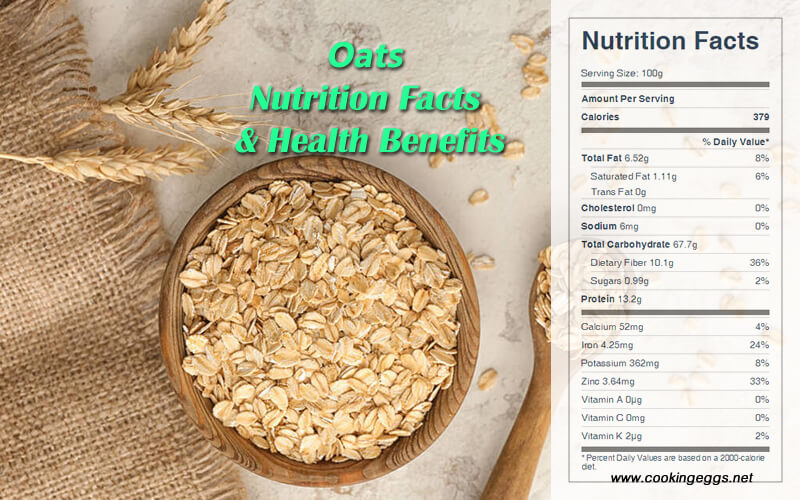Oats Nutrition Facts & Health Benefits
Oatmeal is on virtually every menu of every restaurant serving breakfast in America, and if you only remember to eat a bowl of oats regularly, you’ll be on your way to better health.

The nutritional composition of oats
Oats contain a diverse essential nutrient profile. Oats are a rich source of protein, dietary fiber, several B vitamins, and numerous dietary minerals, especially manganese. Oats are 66% carbohydrates, including 11% dietary fiber and 4% beta-glucans, 7% fat, and 17% protein.
One-half cup of cooked oat bran provides 44 calories, 12.6 g carbohydrate, 3.5 g protein, 0.9 g fat, 6 g dietary fiber, 7 mcg folic acid, 101 mg potassium, 131 mg phosphorus, 11 mg calcium, 44 mg magnesium, and 1.06 mg manganese.
Raw Oats Nutrition Facts Label
Health Benefits of Oats
Oats are an excellent source of the complex carbohydrates that your body requires to sustain energy. They have twice as much protein as brown rice. They’re a rich source of potassium, zinc, copper, manganese, selenium, thiamine, and pantothenic acid. They also contain phytonutrients such as polyphenols, phytoestrogens, lignins, protease inhibitors, and vitamin E (they’re an excellent source of tocotrienols and multiple tocopherols—important members of the vitamin E family). Like many other whole grains, oats are a good source of magnesium, a mineral involved in many of the reactions vital to human metabolism.
Oats are low in calories, high in fiber and protein, and contain phytonutrients that show promise as an aid to reducing heart disease and some forms of cancer. They also contain polyunsaturated fats, vitamin E, and B vitamins. They are very high in calcium, potassium, and magnesium, which, like the B vitamins, are vital to a healthy nervous system as well as strong bones and teeth. Oats supply silicon for healthy arterial walls. They also protect the digestive surfaces and soothe the stomach and intestines.
Oats, oat bran, and oatmeal are famous for providing soluble fiber, which has been shown to help lower cholesterol levels, thus lowering the risk of heart disease. The established property of their cholesterol-lowering effects has led to the acceptance of oats as a healthy food.
Studies have found that eating 3 grams of soluble oat fiber per day can help some people with high cholesterol lower their cholesterol levels by 8 to 23 percent. Since it’s estimated that each 1 percent drop in serum cholesterol translates to a 2 percent decrease in the risk of developing heart disease, oats have become a part of many health programs.
Beta-glucan is a component of the soluble fiber in oats that is also found in some seaweed, mushrooms, and brewer’s yeast. Beta-glucan is believed to help fight bacterial infections. Patients with type 2 diabetes who were given foods rich in beta-glucans experienced much lower spikes in blood sugar than those who were given white rice or white bread.
In addition to the power of oat fiber, researchers have been excited to learn more about the phytonutrients in grains and how they help prevent disease. The germ and bran of oats contain a concentrated amount of phytonutrients, including caffeic acid and ferulic acid. Ferulic acid has been the focus of recent research that shows promising evidence of its ability to prevent colon cancer in animals and other experimental models. Ferulic acid has been found to be a potent antioxidant that is able to scavenge free radicals and protect against oxidative damage. It also seems to be able to inhibit the formation of certain cancer-promoting compounds.
Oats are known for their external soothing properties, so perhaps it’s not surprising that they also provide some special antioxidants. Avenanthramides help prevent free radicals from damaging LDL cholesterol, helping to reduce the risk of cardiovascular disease.
The beneficial effect of oats on blood sugar levels was first reported in 1913. In recent years, researchers have discovered some of the mechanisms that make oats so effective. The same soluble fiber that reduces cholesterol—beta glucan—also seems to benefit those who suffer from type II diabetes. People who eat oatmeal or oat bran-rich foods experience fewer spikes in their blood sugar levels than they could get with, say, white rice or white bread.
The soluble fibers slow the rate at which food leaves the stomach and delays the absorption of glucose following a meal. As stabilizing blood sugar is the goal of anyone with diabetes, this is an extremely beneficial effect. One recent study in the found a low intake of cereal fiber to be inversely associated with a risk for diabetes. The authors conclude: "These findings suggest that grains should be consumed in a minimally refined form to reduce the incidence of diabetes mellitus." This same study also looked at the role of various foods in connection with diabetes. They found a significant inverse association with cold breakfast cereals and yogurt and, not surprisingly, a significant positive association with colas, white bread, white rice, french fries, and cooked potatoes. The more you eat of the latter, the greater your risk for diabetes.
Most of the special nutritional benefits of oats are concentrated in the bran. Oat bran cereal can be an efficient way to maximize those benefits. Oat bran provides about 50 percent more fiber—both soluble and insoluble—than quick oats, and it contains more protein.
The synergy of the nutrients in oats makes them an outstanding and formidable SuperFood. Indeed, the degree of protection against disease offered by oats and other whole grains is greater than that of any of their ingredients taken in isolation. In addition to their power to reduce disease and extend your health span, oats are a flagship SuperFood for practical reasons: they’re inexpensive, readily available, and incredibly easy to incorporate into your life.